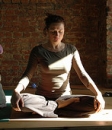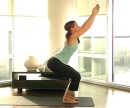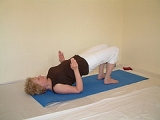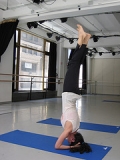Yoga Therapy
 Yoga means ‘union’ occuring between the mind, body and spirit. It means to unite or integrate. Yoga is about the union of a person’s own consciousness and the universal consciousness. Yoga refers to the practice of physical postures or poses. Yoga is an ancient Indian body of knowledge. The word Yoga comes from the Sanskrit word ‘Yuj’. Ancient yogis had a belief that in order of man to be in harmony with himself and his environment, he has to be united in body, mind and spirit. For these three to be in harmony, emotion, action and intelligence must be in balance. This way was formulated to achieve and maintain this balance and it is done through exercise, breathing and meditation. In yoga, the body is treated with care and respect. Yoga exercises improves circulation, stimulates the abdominal organs and puts pressure on the glandular system of the body, which gives you better health.
Yoga means ‘union’ occuring between the mind, body and spirit. It means to unite or integrate. Yoga is about the union of a person’s own consciousness and the universal consciousness. Yoga refers to the practice of physical postures or poses. Yoga is an ancient Indian body of knowledge. The word Yoga comes from the Sanskrit word ‘Yuj’. Ancient yogis had a belief that in order of man to be in harmony with himself and his environment, he has to be united in body, mind and spirit. For these three to be in harmony, emotion, action and intelligence must be in balance. This way was formulated to achieve and maintain this balance and it is done through exercise, breathing and meditation. In yoga, the body is treated with care and respect. Yoga exercises improves circulation, stimulates the abdominal organs and puts pressure on the glandular system of the body, which gives you better health.
Postures Of Yoga:
Yoga caters to the needs of each individual according to his or her specific needs and physical condition. They involve cyclical, vertical and horizontal movements, which provide energy to the system by directing the blood supply to the areas of the body which need it the most. The mind is naturally active and dynamic.
 1. Sukhasana (Sit/Easy Position): Sit crossed-legs with hands on knees. Focus on your breath. Keep your spine straight and push the sit bones down into the floor. Allow the knees to gently lower. If the knees rise above your hips, sit on a cushion or block. This is help support your back and hips. Take 5-10 slow, deep breaths. On the next inhale, raise your arms over your head. Exhale and bring your arms down slowly. Repeat 5-7 times.
1. Sukhasana (Sit/Easy Position): Sit crossed-legs with hands on knees. Focus on your breath. Keep your spine straight and push the sit bones down into the floor. Allow the knees to gently lower. If the knees rise above your hips, sit on a cushion or block. This is help support your back and hips. Take 5-10 slow, deep breaths. On the next inhale, raise your arms over your head. Exhale and bring your arms down slowly. Repeat 5-7 times.
Benefits: A starting position that helps focus awareness on breathing and the body, helps strengthen lower back and open the groins and hips.
2. Tadasana (Mountain): Stand with feet together, hands at your sides, eyes looking forward. Raise your toes, fan them open, then place them back on the floor. Feel your heel, outside of your foot, toes and ball of your foot all in contact with the floor. Tilt your pubic bone slightly forward. Raise your chest up and out, but within reason. Raise your head up and lengthen the neck by lifting the base of your skull towards the ceiling. Stretch the pinky on each hand downward, then balance that movement by stretching your index fingers. Push into the floor with your feet and raise your legs, first the calves and then the thighs. Breathe, hold the posture, but try not to tense up. Breathe. As you inhale, imagine the breath coming up through the floor, rising through your legs and torso and up to your head. Reverse the process on the exhale and watch your breath as it passes down from your head, through your chest and stomach, legs and feet. Hold for 5 or 10 breaths, then leave. On your next inhale, raise your arms over head (Urdhava Hastasana) and hold for several breaths. Lower your arms on an exhale.
Benefits: Improves posture balance and self awareness.
 3. Shalabhasana (Locust Pose): Lying with the belly, chest and legs on the mat raise the legs and upper body. Push the legs together to engage the gluts further. Point back through the toes or ballpoints. Look forward and if the neck hurts, you can always look down. There are many different positions for the hands and arms. They can be interlocked behind the back to increase shoulder flexibility or interlocked behind the head. The hands and arms can also be stretched out in front of you. If you find this posture hard to perform, try it with one leg off the mat. It is a very therapeutic pose for building back strength and relieving bulging discs.
3. Shalabhasana (Locust Pose): Lying with the belly, chest and legs on the mat raise the legs and upper body. Push the legs together to engage the gluts further. Point back through the toes or ballpoints. Look forward and if the neck hurts, you can always look down. There are many different positions for the hands and arms. They can be interlocked behind the back to increase shoulder flexibility or interlocked behind the head. The hands and arms can also be stretched out in front of you. If you find this posture hard to perform, try it with one leg off the mat. It is a very therapeutic pose for building back strength and relieving bulging discs.
Benefits: Deep muscles in the spine are strengthened. To raise the head up and back the Spinalis capitis and semispinalis capitis are tightened and strengthened.
4. Adho Mukta Svanasana (Downward facing dog): Start on your hands and knees. Keep your legs about hip width apart and your arms shoulder width apart. Your middle fingers should be parallel, pointing straight ahead. Roll your elbows so that the eye or inner elbow is facing forward. Inhale and curl your toes under, as if getting ready to stand on your toes. Exhale and straighten your legs; push upward with your arms. The goal is to lengthen the spine while keeping your legs straight and your feet flat on the ground. However, in the beginning it’s okay to bend the knees a bit and to keep your heels raised. The important thing is to work on lengthening the spine. Don’t let your shoulders creep up by your ears — keep them down. Weight should be evenly distributed between your hands and feet. Hold the position for a few breaths. Come down on and exhale. Repeat several times, synchronizing with your breath: up on the exhale and down on the inhale.
Benefits: Builds strength, flexibility and awareness, stretches the spine and hamstrings, rests the heart.
 5. Utkatasana (Chair Pose): From a standing position, with the legs together, slowly bend the knees. If you have a knee problem, be careful. Don’t bend the knees beyond the point of mild discomfort. This is an excellent yoga posture to do especially if you have lower back problems. Try placing something under the knee or above it on the leg that is on the mat if your knee is injured or uncomfortable. Hyper extend the knee that is bent in front of you. Relax forward and the knee is stretched, the posture may be more comfortable. It is hard to stabilize the muscles on the inside and outside of the knees. if you prefer add some distance between the feet. It is easier to evenly distribute the weight over the feet when this is done. The feet can be taken as wide as hip width apart.
5. Utkatasana (Chair Pose): From a standing position, with the legs together, slowly bend the knees. If you have a knee problem, be careful. Don’t bend the knees beyond the point of mild discomfort. This is an excellent yoga posture to do especially if you have lower back problems. Try placing something under the knee or above it on the leg that is on the mat if your knee is injured or uncomfortable. Hyper extend the knee that is bent in front of you. Relax forward and the knee is stretched, the posture may be more comfortable. It is hard to stabilize the muscles on the inside and outside of the knees. if you prefer add some distance between the feet. It is easier to evenly distribute the weight over the feet when this is done. The feet can be taken as wide as hip width apart.
Benefits: This pose increases strength, balance and stability. The hamstrings, quadriceps, gluteals, and the erector muscles of the back are exercised and strengthened. The erector muscles contract isometricly to keep the normal curvature of the spine. Muscles in the arms and shoulders are toned and strengthened.
6. Savasana (The corpse): Possibly the most important posture, the Corpse, also known as the Sponge, is as deceptively simple as Tadasana, the Mountain pose. Usually performed at the end of a session, the goal is conscious relaxation. Many people find the “conscious” part the most difficult because it is very easy to drift off to sleep while doing Savasana. Begin by lying on your back, feet slightly apart, arms at your sides with palms facing up. Close your eyes and take several slow, deep breaths. Allow your body to sink into the ground. Try focusing on a specific part of the body and willing it to relax. For example, start with your feet, imagine the muscles and skin relaxing, letting go and slowly melting into the floor. From your feet, move on to your calves, thighs and so on up to your face and head. Then simply breathe and relax. Stay in the pose for at least 5-10 minutes.
Benefits: Relaxes and refreshes the body and mind, relieves stress and anxiety, calms the mind.
 7. Sethu Bandhasa (The bridge): Lie on your back with your knees up and hands at your side Your feet should be near your buttocks about six inches apart. To begin, gently raise and lower your tail. Then, slowly, raise the tailbone and continue lifting the spine, trying to move one vertebra at a time until your entire back is arched upward. Push firmly with your feet. Keep your knees straight and close together. Breathe deeply into your chest. Clasp your hands under your back and push against the floor. Take five slow, deep breaths. Come down slowly and repeat.
7. Sethu Bandhasa (The bridge): Lie on your back with your knees up and hands at your side Your feet should be near your buttocks about six inches apart. To begin, gently raise and lower your tail. Then, slowly, raise the tailbone and continue lifting the spine, trying to move one vertebra at a time until your entire back is arched upward. Push firmly with your feet. Keep your knees straight and close together. Breathe deeply into your chest. Clasp your hands under your back and push against the floor. Take five slow, deep breaths. Come down slowly and repeat.
Benefits: Increases flexibility and suppleness, strengthens the lower back and abdominal muscles, opens the chest.
8. Dhanurasana (Bow Pose): Lie on your belly , grab the feet, lift the legs into the shape of a bow. Any backward extension of the spine should be done exclusively using the back muscles and should never be forced. In addition, the spine should always be extended fully from hip bones to the head before moving into any pose.
 Benefits: Increases the flexibility of the shoulders and lower back.
Benefits: Increases the flexibility of the shoulders and lower back.
9. Shirsasana (Head stand): The body is completely inverted, and held upright supported by the forearms, while the crown of the head rests lightly on the floor.
Benefits: Increases the flow of blood to the brain, improves memory and other intellect functions.
10. Paschimottanasana (Intense stretch of the west): Sit on the floor with legs flat on the ground. Bend forward from the hips and bring the trunk parallel with the legs.
Benefits: It is done for relaxation.